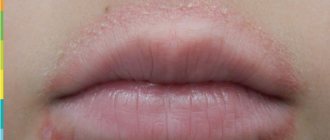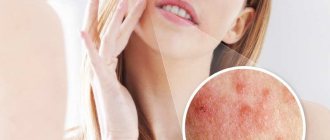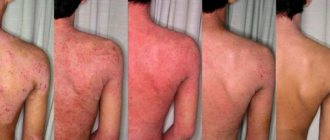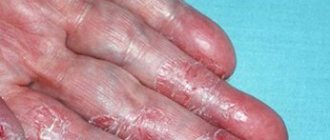Perioral dermatitis
Perioral dermatitis on the face is a disease that affects the skin.
It appears in the form of small pimples that form in the area of the lips and mouth. It is accompanied by unpleasant itching, redness and negative consequences, which can be eliminated through a medical examination and properly selected treatment. In each specific situation, based on the results of the consultation, doctors recommend the patient medications that are relevant to his case. These include specialized pastes, ointments, sometimes hormonal drugs, as well as therapy that quickly eliminates burning and other symptoms. For perioral dermatitis, medications (ointment, tablets, cream) are selected based on medical diagnosis and tests. You can purchase the necessary medications for treatment on our website “Pharmacy 911”.
In what cases does perioral dermatitis occur?
The causes of perioral dermatitis are varied. During a detailed interview, the doctor tries to establish the cause of this condition in a particular patient, since further treatment depends on this. Most often, the development of the disease is associated with the following factors:
- prolonged and uncontrolled use of creams and ointments containing corticosteroids;
- the use of fluoride-containing products, for example the use of toothpaste with a high fluoride content;
- prolonged and uncontrolled use of products containing antibiotics;
- prolonged exposure to aggressive components included in some cosmetics and foundations;
- hormonal disorders.
Perioral dermatitis is similar to seborrheic dermatitis, rosacea and other skin diseases, so only a doctor can prescribe an accurate diagnosis and correct treatment. Therefore, only by seeking advice can you understand for sure that this is perioral dermatitis and receive the correct treatment regimen.
Manifestations of the disease
Perioral dermatitis can manifest itself in the chin, eyelids, corners of the lips, nasolabial and nasobuccal folds in the form of single papules, as well as in the form of extensive lesions. Papules are round, convex formations of red or pink color. There is itching and burning in the area of the rash. But there are also cases when papules do not cause any inconvenience other than aesthetic ones.
The affected areas of the skin feel uneven to the touch. In the area of papules, weeping may occur and crusts may subsequently form.
It is worth noting that most often papules form in the chin area and around the mouth rather than on the eyelids. There are also cases of mixed lesions, when papules spread over the entire face.
Possible negative consequences
If you do not seek medical help in time, wounds with pus may form in place of the papules. In this case, the percentage of affected skin will be much greater than at the beginning of the disease. Patients at particular risk are:
- with weakened immunity;
- with hormonal imbalance;
- childhood;
- with concomitant skin diseases.
The course of dermatitis can worsen with the concomitant use of various medications, for example, hormonal contraceptives, as well as during pregnancy, when the skin is exposed to ultraviolet radiation, cold, wind, and dry indoor air.
Diagnosis of the disease
To accurately diagnose this type of dermatitis, you may need not only a doctor’s examination, but also additional manipulations, for example, scraping from the affected area of skin for microscopic examination, bacterial culture. Laboratory diagnostics may reveal:
- presence of demodex mite;
- increased microbial contamination of the skin;
- thinning of the skin with signs of inflammation based on biopsy results.
The difficulty can be considered the absence of a specific causative agent of perioral dermatitis, common for all patients, as well as nonspecific skin changes that may be present in other diseases.
Causes of perioral dermatitis
Various factors become prerequisites for the occurrence of the disease. It is generally accepted that the disease can occur in waves, during which the irritation on the skin passes and reappears. Doctors often identify hormonal changes as the cause of perioral dermatitis. Symptoms appear as a result of:
- the use of drugs based on corticosteroids, which provoke the occurrence of rosacea, acne, blackheads and other cosmetic problems
- pregnancy, when the body is at the stage of serious changes and hormonal changes. Dermatitis often worsens before the onset of menstruation.
- using inappropriate decorative cosmetics
- the use of pastes with fluoride, which provoke irritation of the epidermis
- chapping after walking in the cold or sunbathing
- infectious diseases
- problems with immunity. They are usually caused by not getting enough vitamins.
Having discovered a corresponding problem, it is better to immediately go to see a doctor and find out how to treat perioral dermatitis on the face in adults.
Seborrheic dermatitis on the head, treatment
Seborrheic dermatitis on the head manifests itself in the form of ordinary dandruff, but you should not ignore it. If the disease starts and you do not go to the clinic in a timely manner, hair loss may begin. Treatment of seborrheic dermatitis on the head should begin immediately.
Seborrhea is characterized as a malfunction in your body associated with hormonal disorders, in which a change in the functionality of the sebaceous glands occurs. They begin to produce an increased amount of “sebum”. In this regard, the work of the natural protective barriers of the skin is disrupted, but a favorable environment appears for the influence of pathogenic bacteria and organisms. The disease is subject to cyclicality, which means that dermatitis on the head mainly begins in the winter, and in the summer there comes a more or less calm period. If the ends of your hair begin to split, then this may be one of the signs of seborrheic dermatitis on the head. Dermatologists, in addition to general medications, also prescribe special products for washing your hair. These are shampoos for the treatment of dermatitis on the head, which contain zinc pyrithione, tar, and iron sulfide. In severe forms of the disease, after a special shampoo, a lotion containing cliochenol with hydrocartisol is prescribed. But in any case, if you notice signs on your head, consult a doctor immediately!
Symptoms of the disease
The first sign that you need to undergo an examination is the appearance of small blisters (papules) in the mouth and chin. In severe cases, they can spread throughout the face, reaching the cheeks, nose, eyes and temples. Papules are filled with clear liquid. Color varies from flesh-colored to pink to bright red depending on the stage of the disease. Pimples appear singly or in groups. The skin in these areas becomes rough. Bursting, papules form crusts. If you accidentally touch one, pigmentation will eventually remain on the skin.
Patients do not always experience serious pain. The sooner treatment of perioral dermatitis on the face in children and adults begins, the easier it is to get rid of the disease, and the lower the risk of unpleasant consequences. When you notice the first symptoms of the disease, make an appointment with a dermatologist.
Risk groups and similar diseases
Signs of the disease are most often found in women, but children and adolescents periodically experience them due to weakened immunity. In place of the blisters, ulcers often form. When spread over the entire face, it becomes a threat to vision, which is especially important in the situation with children. Therefore, when checking with a specialized doctor about how to treat perioral dermatitis in children, it is worth paying a visit to an ophthalmologist.
In the case of teenagers, the disease may not be detected immediately, because, experiencing hormonal changes, boys and girls often encounter skin problems. Blackheads and acne affect most people, so it can be difficult to notice papules at an early stage. Patients prone to allergies also rarely accurately diagnose the disease. Perioral dermatitis in children is often attributed to hormonal imbalance.
General notes on therapy
The choice of drug and treatment method for perioral dermatitis depends on the severity and stage of the disease.
For the period of treatment, regardless of the chosen method of therapy, stop using cleansing and moisturizing cosmetics, decorative cosmetics, fluoridated toothpastes, as well as external and systemic drugs containing glucocorticosteroids (when discontinuing systemic drugs containing glucocorticosteroids, it is necessary to take into account the indications for which the drugs were prescribed , the patient should be advised to consult the doctor who prescribed them regarding possible discontinuation of the drug). There are “zero”, external and systemic therapy for perioral dermatitis. For mild perioral dermatitis, “zero” therapy is sufficient, which consists of abolishing all external, including cosmetic, products, especially drugs containing glucocorticosteroids. Improvement occurs on average within 2 weeks. If it is ineffective, drug therapy is prescribed.
Indications for hospitalization
None.
Requirements for treatment results
Regression of rashes.
Prevention
- limiting the use of drugs containing glucocorticosteroids;
- limiting the use of cosmetics.
External therapy
Prescribed for mild to moderate severity of the disease, used as monotherapy, and for severe perioral dermatitis it can be prescribed in combination with systemic therapy:
- Metronidazole, 1% cream 2 times a day externally for 8 weeks
- azelaic acid, 20% cream 2 times a day externally for 2-6 weeks
- pimecrolimus, 1% cream 2 times a day externally for 4 weeks
Note. In the instructions for medical use of azelaic acid and pimecrolimus, perioral dermatitis is not included in the indications for use of the drug.
Systemic therapy
Prescribed for severe forms of the disease, as well as when external therapy is ineffective:
- tetracycline 250-500 mg 2 times a day orally for 4-8 weeks. Prescribed to patients over 8 years of age.
- For tetracycline intolerance in pregnant women, children under 8 years of age and for granulomatous form of perioral dermatitis in children: erythromycin 250 mg 2 times a day orally for 1 to 3-4 months.
Note. In the instructions for medical use of tetracycline and erythromycin, perioral dermatitis is not included in the indications for use of the drug.
If antibacterial therapy is ineffective, isotretinoin 0.1-0.7 mg per kg body weight is prescribed orally once a day for 6-20 weeks.
Note. In the instructions for medical use of isotretioin, perioral dermatitis is not included in the indications for use of the drug.
Diagnosis of perioral dermatitis
Having noticed the first signs of the disease, having felt unpleasant symptoms, you need to make an appointment with a specialized specialist. The initial appointment with a doctor consists of an examination, a description of the medical history based on the patient’s complaints and information about the individual characteristics of his body and possible reactions.
Before treating perioral dermatitis, tests are one of the mandatory procedures. They allow you to identify the prerequisites for the development of the disease and accurately diagnose it, without confusing it with herpes, rosacea and other skin lesions. You will need:
- Dermatoscopy. Gives an assessment of the epidermis and helps assess the course of the disease
- Scrapings. Determine the infectious nature if the symptoms have a corresponding origin
- Allergy tests. Demonstrate the level of skin sensitivity to staphylococcus and streptococcus
As a result of the examination, the doctor explains to the patient how to cure perioral dermatitis, clinical recommendations are entered into the disease record. A course of medications and therapy is prescribed.
Treatment of perioral dermatitis
A confirmed diagnosis usually requires an integrated approach. The treatment regimen involves a complete refusal of cosmetics, as well as corticosteroid drugs. The patient is advised to use antihistamines to relieve burning and itching. Herbal lotions are used to help reduce inflammation. Reflexology is used to stop symptoms by pressing on specific points or placing special needles.
Having weakened the symptoms, you can resort to the use of antibiotics to get rid of the infection if it is diagnosed during the examination. For perioral dermatitis, medications are prescribed by a doctor taking into account age, body characteristics, allergies and pregnancy. Strengthening the immune system and restoring the balance of intestinal microflora are important. The latter may require a specific diet. Avoid fried, spicy and fatty foods, snacks, sweets and fast food. Give up alcohol and cigarettes.
Prevention
Treatment with ointment for perioral dermatitis is not always a panacea. In some cases, the disease can return, so the course of taking medications can be long. Any irritant often leads to the appearance of the disease. Following simple recommendations will help you avoid possible risks:
- Check the composition of cosmetic products and treat their choice with special attention
- Don't neglect personal hygiene
- Strengthen your immunity
- Eat right and monitor your digestive health
- Be aware of allergies
- Monitor hormonal balance during pregnancy, in case of possible changes due to nervousness, illness or other reasons
Perioral dermatitis detected at the first stage is the easiest and fastest to treat, so remain sensitive to the body’s signals and begin the fight against the first symptoms of the disease in a timely manner.
Causes
The exact causes of the development of perioral dermatitis are not known, but trigger factors have been identified, i.e. provoking:
- Deterioration, weakening of immunity;
- Climate change;
- Exposure to ultraviolet rays;
- Use of corticosteroids;
- Fluoridated toothpaste;
- Genetic predisposition;
- The use of low-quality cosmetics against the background of a tendency to allergic reactions to cosmetics;
- Emotional stress.
The most reliable seems to be the development of perioral dermatitis in connection with long-term local use of corticosteroid ointments against the background of other provoking factors. There is a decrease in local immunity, which gives impetus to the development of the inflammatory process.
Bibliography
- Adaskevich V.P. Perioral dermatitis: clinical picture, diagnosis, treatment / V.P. Adaskevich // Dermatology. – 2008. – No. 1. – P. 17–20.
- Grashkin V. A. Diagnostic criteria, epidemiology and substantiation of clinical and pathogenetic types of perioral dermatitis / V. A. Grashkin, M. S. Gromov // Voenmed. magazine – 2010. – No. 10. – P. 32–45.
- Rodionov A. N. Dermatocosmetology. Lesions of the facial skin and mucous membranes. Diagnostics, treatment, prevention / A. N. Rodionov. – St. Petersburg. : Science and technology, 2011. – 912 p.
- Karelina O. Yu. Perioral dermatitis: treatment with azelaic acid / O. Yu. Karelina, Yu. M. Karelin // Klin. dermatology and venereology. – 2006.
Popular questions about perioral dermatitis
How can you get perioral dermatitis?
Dermatitis is not contagious, as it is an individual reaction of the body to the use of fluoride-containing pastes, inappropriate cosmetics and drugs containing corticosteroids. In the case of diagnosing infectious preconditions for a disease, it is worth finding out its nature, but it will not become a reason to limit communication.
How does perioral dermatitis manifest?
The disease is characterized by the formation of papules, blisters filled with colorless liquid, which spread around the mouth and along the chin, rising to the eyes. Dry skin, itching and burning accompany the disease, but in the first stage patients experience minimal discomfort.
Is it possible to cure perioral dermatitis?
The disease is easily treatable if you follow your doctor’s recommendations, use the necessary medications and avoid products and products that can cause perioral dermatitis. Depending on the extent of the damage, the course can take from several days to several months.
Preventive measures
The key preventive measures to prevent the development of perioral dermatitis are:
- protection of facial skin from exposure to sunlight;
- maintaining proper nutrition with minimal consumption of hot and salty seasonings;
- minimizing skin dryness;
- use high-quality cosmetics from trusted manufacturers.
Although perioral dermatitis does not pose a health threat, treatment is necessary.







